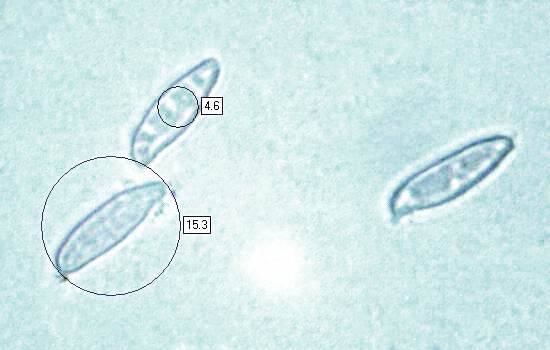Pseudoboletus parasiticus (Bull.) Šutara - Parasitic Bolete
Phylum: Basidiomycota - Class: Agaricomycetes - Order: Boletales - Family: Boletaceae
Distribution - Taxonomic History - Etymology - Identification - Culinary Notes - Reference Sources
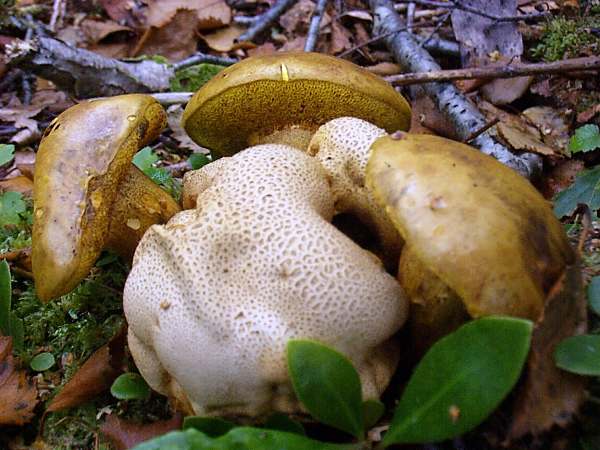
Pseudoboletus parasiticus (synonym Xerocomus parasiticus) is unlikely to be confused with any other species, because it occurs only with the Common Earthball, Scleroderma citrinum. It is a rare bolete, and most of the earthballs you come across are not accompanied by this dull-looking fungus. At one time thought to be parasitic on the earthballs, these boletes are now believed to do little or no damage to their 'partners' - but before concurring just look at the shrivelled form of the earthball in this picture!
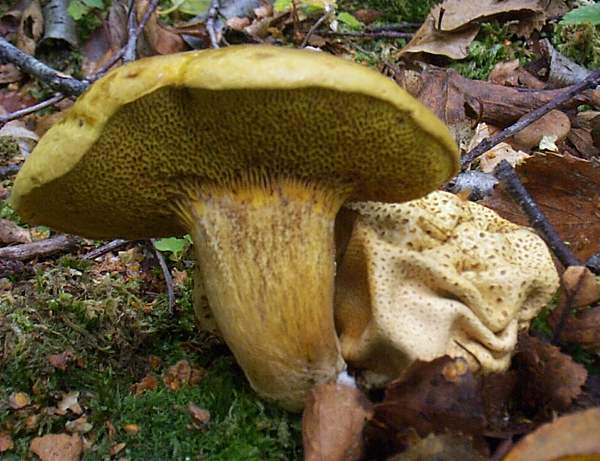
Distribution
Occurring throughout Britain and Ireland, but with a localised distribution, this bolete is an uncommon to rare find. The Parasitic Bolete is found also in most countries in central and northern Europe but is seldom recorded in the Mediterranean region. This bolete is also reported from some parts of North America.
Taxonomic history
In 1790 Jean Baptiste Francois (Pierre) Bulliard described this mushroom and gave it the scientific name Boletus parasiticus by which it was widely known until 1888, when Lucien Quelet transferred it to the genus Xerocomus, renaming it Xerocomus parasiticus. In 1991 the famous Czech mycologist Josef Šutara (born 1934), a renowned authority on boletoid fungi, redefined the Parasitic Bolete as Pseudoboletus parasiticus, which is now its generally-accepted scientific name.
Synonyms of Pseudoboletus parasiticus include Boletus parasiticus Bull., and Xerocomus parasiticus (Bull.) Quel.
Etymology
The specific epithet parasiticus was chosen when mycologists though that this bolete was parasitising 'live' fruitbodies of the Common Earthball, Scleroderma citrinum; now many believe that these boletes simply consume decaying earthballs... but is a fruitbody that still contains potentially viable spores truly 'dead'?
Identification Guide
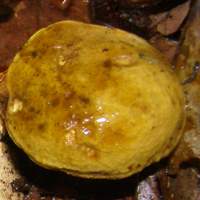 |
CapYoung caps are hemispherical and downy, becoming smooth and expanding as the fruiting bodies mature. When fully expanded, the caps of Pseudoboletus parasiticus range from 2 to 6cm in diameter. The cap surface is greasy in wet weather but often becomes cracked in dry weather, revealing the thick pallid flesh beneath the cuticle. |
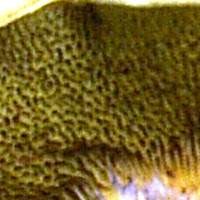 |
Tubes and PoresLarge tubes terminate in angular olive pores that are at first yellow but darken through olive to olive-brown as the fruitbody matures. When cut or bruised, neither the tubes nor the pores change colour appreciably, and there is no hint of bluing. |
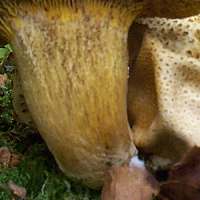 |
StemBecause it emerges from beneath a Common Earthball, the stem of the Parasitic Bolete is invariably curved. Olive or sienna, the stem tapers in towards the base; its pale lemon flesh does not change colour upon exposure to air. Between 1 to 2cm in diameter at the mid point, the stem is typically 3 to 6cm long. There is no stem ring. |
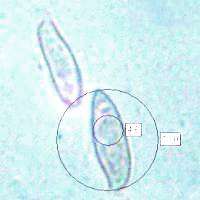 |
SporesSubfusiform, smooth, 12-18.5 x 3.5-5µm. Spore printOlive-brown. |
Odour/taste |
Not distinctive. |
Habitat & Ecological role |
Found only as a parasite of the Common Earthball, Scleroderma citrinum. This species is more likely to occur in regions where the soil is calcareous. |
Season |
August to October in Britain and Ireland. |
Similar species |
Boletus Chrysenteron has a reddish stem, usually untapered. |
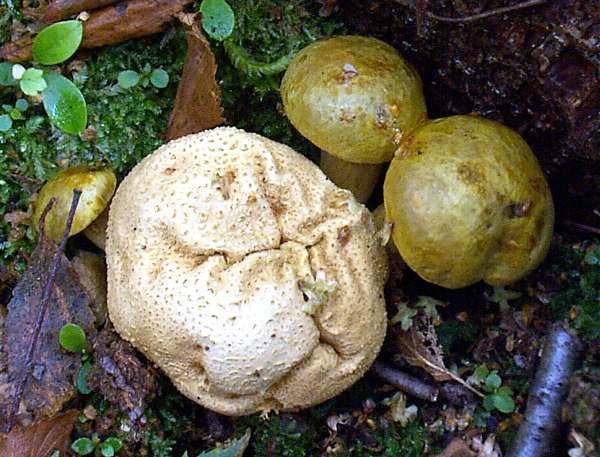
Culinary Notes
The Parasitic Bolete is inedible.
Reference Sources
Fascinated by Fungi, 2nd Edition, Pat O'Reilly 2016, reprinted by Coch-y-bonddu Books in 2022.
BMS List of English Names for Fungi
Dictionary of the Fungi; Paul M. Kirk, Paul F. Cannon, David W. Minter and J. A. Stalpers; CABI, 2008
Taxonomic history and synonym information on these pages is drawn from many sources but in particular from the British Mycological Society's GB Checklist of Fungi.
Fascinated by Fungi. Back by popular demand, Pat O'Reilly's best-selling 450-page hardback book is available now. The latest second edition was republished with a sparkling new cover design in September 2022 by Coch-y-Bonddu Books. Full details and copies are available from the publisher's online bookshop...
